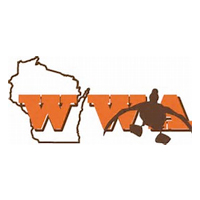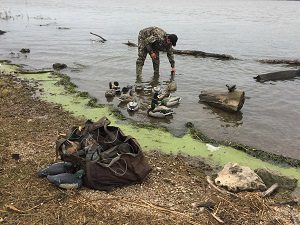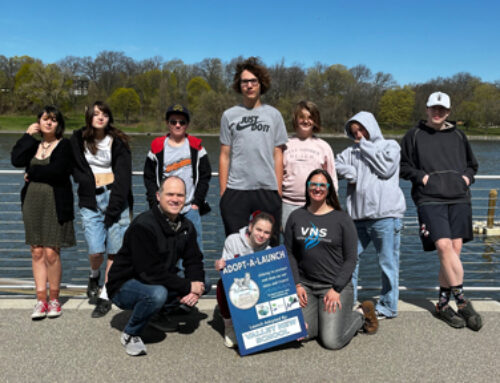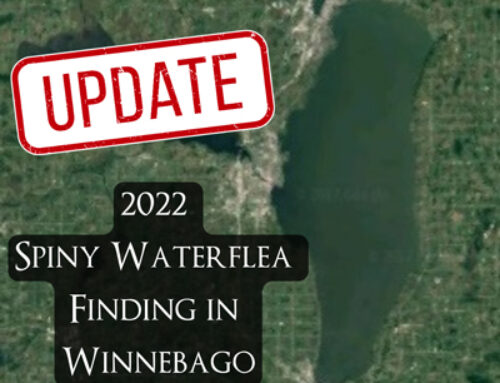WWA’s Hunter’s Eve Bash and DNR Campaign Waterfowl Hunter Weekend Spread Message of AIS Prevention
As waterfowl hunting season gets underway, hunters work to help protect their lakes and wetlands from aquatic invasive species (AIS). The Wisconsin Waterfowl Association (WWA) held a kick off event on August 30th at Waverly Beach Bar and Grille in Menasha. This Hunter’s Eve Bash is an annual event held by the WWA and included raffles, games, and food. Our Winnebago Waterways AIS Coordinator Chris was invited to have a booth with AIS specimens,  talk with hunters about AIS, and discuss AIS prevention. With hunting gear and dogs, there are many ways that aquatic hitchhikers can get stuck in fur, on push poles, duck decoys, etc. and be transported to favorite lakes and hunting grounds. Hunters at the Hunter’s Eve Bash were interesting in learning about AIS and hope to protect their lakes through the AIS prevention steps!
talk with hunters about AIS, and discuss AIS prevention. With hunting gear and dogs, there are many ways that aquatic hitchhikers can get stuck in fur, on push poles, duck decoys, etc. and be transported to favorite lakes and hunting grounds. Hunters at the Hunter’s Eve Bash were interesting in learning about AIS and hope to protect their lakes through the AIS prevention steps!
During opening weekend for waterfowl at the end of September, Fox-Wolf aided with the DNR Waterfowl Opening Hunters Weekend Campaign. It was the third year of Waterfowl Hunter AIS Outreach when teams of DNR staff, statewide AIS Partners and volunteers were stationed at access points on opening days in the Mead Wildlife Area, Big Muskego, Horicon Marsh, in multiple counties, and along the Mississippi River to talk to hunters about AIS and what they can do to stop the spread. Modeled after the successful Clean Boats Clean Waters (CBCW) program that reaches boaters all summer long, boat inspectors/educators  conducted a hunting version of the CBCW survey and talk with them about specific aspects of duck hunting that risk AIS movement. Mud, for example, can hide seeds, the bulbils of starry stonewort, and the eggs or larvae of tiny invaders, such as spiny waterfleas. Of particular concern to the hunters is the Faucet snail. These snails carry intestinal flukes that can kill thousands of ducks if they eat them.
conducted a hunting version of the CBCW survey and talk with them about specific aspects of duck hunting that risk AIS movement. Mud, for example, can hide seeds, the bulbils of starry stonewort, and the eggs or larvae of tiny invaders, such as spiny waterfleas. Of particular concern to the hunters is the Faucet snail. These snails carry intestinal flukes that can kill thousands of ducks if they eat them.
Just a few minutes of preventative action can protect our hunting tradition for generations to come. Before launching into and leaving a waterbody, hunters must:
Inspect waders, boats, trailers, motors and hunting equipment, including boots, blinds and dogs.
Remove all plants, animals and mud.
Drain all water from decoys, boats, motors, livewells and other hunting equipment.
Never move plants or live fish away from a water body.
A special consideration for waterfowl hunters is to remove all seed heads and roots when using vegetation for your duck blinds. It is important to note that it is illegal to use phragmites in Fond du Lac, Calumet, and Winnebago counties where the plant is listed as prohibited by WI law.
This article was written by Chris Acy, the AIS Coordinator for the Winnebago Waterways Program covering Fond du Lac, Calumet, and Winnebago Counties.
To learn more about invasive species and their impacts to Wisconsin’s waters and economy, visit DNR.wi.gov and search “Invasive Species”.
Questions? Comments? Contact Chris Acy, our Aquatic Invasive Species Coordinator at (920) 460-3674 or chris@fwwa.org!
Winnebago Waterways is a Fox-Wolf Watershed Alliance program. The Fox-Wolf Watershed Alliance is an independent nonprofit organization that identifies and advocates effective policies and actions that protect, restore, and sustain water resources in the Fox-Wolf River Basin.





